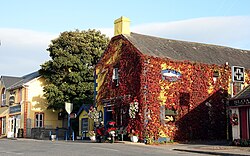Castleconnell
Castleconnell
An Caisleán Uí Chonaill | |
|---|---|
Town | |
 Castleconnell town centre | |
| Country | Ireland |
| Province | Munster |
| County | County Limerick |
| Population (2006)[1] | |
| • Total | 1,330 |
| Time zone | UTC+0 (WET) |
| • Summer (DST) | UTC-1 (IST (WEST)) |
| Irish Grid Reference | R660627 |
Castleconnell (Irish: Caisleán Uí Chonaill) is a scenic village on the banks of the River Shannon, some 11 km (6.8 mi) from Limerick city and within a few minutes walk of the boundaries with counties Clare and Tipperary.
Many fine nineteenth-century buildings overlook the Shannon in Castleconnell. One of these, the former schoolhouse, is now home to the Irish Harp Centre, run by noted harpist Janet Harbison and her husband. Another, the former convent, is now the Castleoaks House Hotel, which (because of its scenic location) is a popular venue for wedding receptions. A little south of the village lies the ruins of the once-grand Mountshannon house, a Palladian mansion gutted by fire early in the 20th century.
The village centre has recently seen development activity including the building of new shop and business premises. There has also been much high density housing development in the area in recents times, due to its close proximity to Limerick city. These developments have come under some criticism from locals who claim that they are not in keeping with the character or development plans of the village.
History

The ruins of the 'Castle of Connell' (in fact the castle of a family named Gunning), from which the name of the village derives, was built on a rock outcrop overlooking the bend of the river. Castleconnell was the turning point in Edward Bruce's 1317 campaign in Ireland. He stayed there in early April 1317 and having failed to secure the surrender of Limerick retreated (McNamee, Colm, The Wars of the Bruces, Tuckwell Press, 1997). It was destroyed in a siege by the army of General Ginkel, fighting in support of the Army of William of Orange at the end of the 17th century. Even today a large chunk of the castle wall lies some fifty feet from the castle, thrown clear across the road by siege cannons. A footbridge over the Shannon - built during the 1939-1945 Emergency by the Irish Army under Captain Carley Owens - connects counties Limerick and Clare. The nearby Mountshannon House is a testament to John FitzGibbon, 1st Earl of Clare, who in the late 18th century was the Attorney-General for Ireland and subsequent Lord Chancellor of Ireland. FitzGibbon was a protestant hardliner and helped usher in the Acts of Union 1800, which resulted in the Irish parliament's abolition. The fine house where he and his descendants lived was burnt to the ground by IRA rebels in the 1920's. Today, the house lies in ruins with the foundations crumbling. It is thought by many to be beyond repair, due to decades of negligence.
Fishing
Known for its fishing - both coarse and sport - it has a history as a fishing destination stretching back into the 19th century. Reputedly fished by royalty in those days (and by distinguished figures such as former Republic of Ireland football manager Jack Charlton these days), many fine salmon and trout have been caught in its environs. In face, the local turn-of-the-century era pub known as the Shannon Inn became well known for its fishing clientele that stayed there over the years. Castleconnell was also home to the world famous Fly Fisherman John Enright. He also designed world famous fishing rods that were apparently a favourite of Tsar Nicholas II of Russia . The Shannon Electricity Scheme and its Ardnacrusha dam at Parteen changed the fortunes of the village considerably in the 1930s when it reduced the flow of water south of the dam to approximately one sixth, dropping water levels along the Shannon.
The engineers added a fish lift to the dam, allowing fish to be lifted in a water-filled container and thereby pass upstream to their traditional spawning beds. The river at Castleconnell is also known for its rich bird life, and particularly its swans, many of which are migratory Icelandic Whooper Swans wintering and breeding on the river. The native swans are mute.
Sport
Gaelic games
Castleconnell is the home of Limerick's most successful hurling club. The Ahane GAA club won 19 Limerick Senior Hurling Championships between 1931 and 1948 and provided many of the Limerick team that won All-Ireland Senior Hurling Championships in 1934, 1936 and 1940. Among its most famous players were Mick Mackey and Jackie Power.
Boxing
Boxer Andy Lee was raised in Castleconnell from the age of 14.
Rowing
Castleconnell boat club has been in existence since 1983. It is located at Worrell's End. Castleconnell has one of the best stretches of water to row on in Ireland. Rowers have a smooth, wide water to row on for 3.2 kilometers till O' Briens bridge. Just beyond the bridge, the rower's have another 1.5 kilometers before they come to a water flow regulator.
Transport
Castleconnell railway station opened on 8 August 1858.[2] the station lies on the Limerick–Ballybrophy railway line.
Notable Rresidents
- Bulmer Hobson (died 1968.)
- Andy Lee,
- Pat Shortt
- Marcus Horan
- Paul Warwick
See also
References
- ^ "Census 2006 – Volume 1 – Population Classified by Area" (PDF). Central Statistics Office Census 2006 Reports. Central Statistics Office Ireland. 2007. Retrieved 2011-06-29.
{{cite web}}: Unknown parameter|month=ignored (help) - ^ "Castleconnell station" (PDF). Railscot - Irish Railways. Retrieved 2007-09-05.
